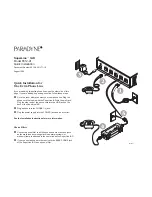
Independent fabric merge
Merge fabrics by disabling the effective configuration on one fabric and then connecting both fabrics.
After you connect the fabrics, devices in the second fabric are not accessible until you add them to
the effective configuration.
CAUTION:
When you disable the effective configuration, the fabric becomes accessible to all servers.
To merge two fabrics without disabling the effective configuration for entire fabrics, disable at least
one switch in each fabric or use an additional switch. Use the disabled switch to merge the fabrics
and create the new configuration.
High-availability redundant fabric merge
With redundant fabrics, you can merge a fabric by taking it offline and redirecting I/O to the other
fabric. Current I/O operations are not affected; however, during the merge, the hosts operate in
degraded mode without redundant data path protection. With proper planning, you can minimize
downtime. After completing and verifying the fabric merge, bring the first fabric online by restoring
the I/O paths. After you restore the I/O paths on the first fabric, you can repeat the merge process
for the second fabric.
Merging high-availability fabrics example
In the following procedure, the SAN consists of fabric A and a redundant fabric B. Each of these
fabrics is merged with a SAN consisting of fabrics C and D.
1.
Identify and resolve any issues that can cause fabric segmentation.
2.
Verify that each fabric provides a redundant path to all attached devices.
3.
Verify that paths are open to each device that must remain online during the merge.
4.
Select fabrics for merging, for example, fabric A with fabric C.
5.
Close all active paths on the fabric selected for merging and prepare devices for downtime. For
example, use multipathing software to redirect I/O by performing a failover to the alternate path.
6.
Verify that the fabric selected for merging has no I/O activity.
7.
Connect the selected fabrics (fabric A and fabric C).
8.
Verify that the newly merged fabric contains all switches and that the zoning has merged correctly.
9.
Restore I/O operations on the new fabric from the multipathing software console.
10.
Verify that paths are open and restored for each device.
11.
Ensure that all paths and I/O operations have been restored.
Repeat this procedure to merge fabric B with fabric D.
SAN Design Reference Guide
427
Summary of Contents for StorageWorks 4000/6000/8000 - Enterprise Virtual Arrays
Page 26: ......
Page 34: ...SAN design overview 34 ...
Page 60: ...SAN fabric topologies 60 ...
Page 80: ...Fibre Channel routing 80 ...
Page 82: ......
Page 92: ...H series switches and fabric rules 92 ...
Page 156: ...C series switches and fabric rules 156 ...
Page 182: ...SAN fabric connectivity and switch interoperability rules 182 ...
Page 184: ......
Page 270: ...XP and VA storage system rules 270 ...
Page 276: ...Enterprise Backup Solution 276 ...
Page 278: ......
Page 354: ...SAN extension 354 ...
Page 398: ...Network Attached Storage 398 ...
Page 400: ......
Page 416: ...Storage security 416 ...
Page 428: ...Best practices 428 ...
Page 456: ...456 ...
















































